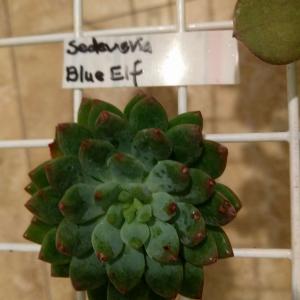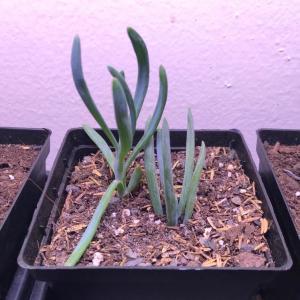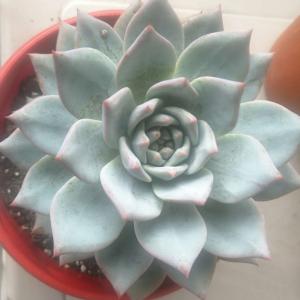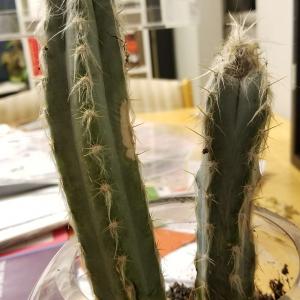文章
Miss Chen
2018年02月25日

Description: This is a herbaceous perennial plant about 2-4' tall and mostly unbranched, except toward the apex. The central stem is round, glabrous, and occasionally glaucous. The grey- or blue-green alternate leaves are up to 15" long and 1" across. They are linear, although wider at the base, where the leaves wrap around the stem in sheaths, than at the tip. They are also glabrous, with parallel venation and smooth margins, tending to bend downward towards the middle. The light violet to blue-violet flowers occur in small clusters on hairless flowering stems at the top of the plant. Underneath each inflorescence are 2 small bracts, each up to 3" long and less than ½" across. Each flower is about 1" across, with 3 rounded petals, 6 bright yellow anthers, and fine spidery violet hairs near the base. The flowers open up during the morning and close by the afternoon in sunny weather, but remain open longer on cloudy days. There is no floral scent.
The blooming period occurs from late spring to mid-summer, and lasts about 1½ months, during which time only a few flowers are in bloom at the same time. The mature seed capsules split into 3 sections, each capsule releasing 3-6 oval to oblong, brown seeds. The root system is thick, fleshy, and fibrous, sending off occasional offshoots nearby.
Cultivation: The preference is full or partial sun, and moist to slightly dry conditions. The soil can contain loam, clay, gravel, or sand – this plant is very adaptable. Sometimes the leaves develop brown blotches or turn yellow in response to harsh weather conditions, competition from other plants, or age.

Range & Habitat: The native Ohio Spiderwort is a common plant throughout Illinois, except in the SE, where it is uncommon or absent (see Distribution Map). It is often found in moist to mesic black soil prairies and sand prairies. Other habitats include sandy black oak savannas, Bur Oak savannas, limestone glades, thickets and woodland borders, moist meadows near woods or rivers, roadside ditches, and areas along railroads (including the ballast). Plants are usually widely scattered, but sometimes appear in sizable colonies in disturbed areas.
Faunal Associations: The most important pollinators of the flowers are long-tongued bees, especially bumblebees. Other visitors include Halictine bees and Syrphid flies. However, the Syrphid flies feed on stray pollen and are non-pollinating. Spiderwort is rarely bothered by insects, although Lema collaris (Leaf Beetle sp.) reportedly feeds on the foliage. Mammalian herbivores also eat the plant, including the White-Tailed Deer, Cottontail Rabbit, Box Turtles, and livestock. The foliage is non-toxic to these animals.

Photographic Location: The close-up photograph of the flowers was taken along a railroad in Champaign, Illinois, while the photographs of the flowering plant and close-up of the stem were taken at the wildflower garden of the webmaster in Urbana, Illinois. Ohio Spiderwort is more resistant to the application of herbicides along railroads than most plants, which is one reason why it remains common in such areas.
Comments: This is probably the most common Spiderwort in Illinois. The flowers are short-lived, but beautiful, particularly when they are viewed close-up. Ohio Spiderwort can be readily distinguished from Virginia Spiderwort by the absence of conspicuous hairs on the flowering stems near the inflorescence, and the greyish or bluish appearance of the thin leaves. It also tends to be taller and more spindly in appearance than other species of Spiderwort, and has smaller bracts subtending the inflorescence. The leaves and stems are reported to be edible – fresh or cooked.
The blooming period occurs from late spring to mid-summer, and lasts about 1½ months, during which time only a few flowers are in bloom at the same time. The mature seed capsules split into 3 sections, each capsule releasing 3-6 oval to oblong, brown seeds. The root system is thick, fleshy, and fibrous, sending off occasional offshoots nearby.
Cultivation: The preference is full or partial sun, and moist to slightly dry conditions. The soil can contain loam, clay, gravel, or sand – this plant is very adaptable. Sometimes the leaves develop brown blotches or turn yellow in response to harsh weather conditions, competition from other plants, or age.

Range & Habitat: The native Ohio Spiderwort is a common plant throughout Illinois, except in the SE, where it is uncommon or absent (see Distribution Map). It is often found in moist to mesic black soil prairies and sand prairies. Other habitats include sandy black oak savannas, Bur Oak savannas, limestone glades, thickets and woodland borders, moist meadows near woods or rivers, roadside ditches, and areas along railroads (including the ballast). Plants are usually widely scattered, but sometimes appear in sizable colonies in disturbed areas.
Faunal Associations: The most important pollinators of the flowers are long-tongued bees, especially bumblebees. Other visitors include Halictine bees and Syrphid flies. However, the Syrphid flies feed on stray pollen and are non-pollinating. Spiderwort is rarely bothered by insects, although Lema collaris (Leaf Beetle sp.) reportedly feeds on the foliage. Mammalian herbivores also eat the plant, including the White-Tailed Deer, Cottontail Rabbit, Box Turtles, and livestock. The foliage is non-toxic to these animals.

Photographic Location: The close-up photograph of the flowers was taken along a railroad in Champaign, Illinois, while the photographs of the flowering plant and close-up of the stem were taken at the wildflower garden of the webmaster in Urbana, Illinois. Ohio Spiderwort is more resistant to the application of herbicides along railroads than most plants, which is one reason why it remains common in such areas.
Comments: This is probably the most common Spiderwort in Illinois. The flowers are short-lived, but beautiful, particularly when they are viewed close-up. Ohio Spiderwort can be readily distinguished from Virginia Spiderwort by the absence of conspicuous hairs on the flowering stems near the inflorescence, and the greyish or bluish appearance of the thin leaves. It also tends to be taller and more spindly in appearance than other species of Spiderwort, and has smaller bracts subtending the inflorescence. The leaves and stems are reported to be edible – fresh or cooked.
0
0
文章
Miss Chen
2018年02月22日

Description: This perennial plant is 1½–3' tall and more or less erect. It is usually unbranched below, while branching occasionally above. The stems are light green or light blue, glabrous, and often glaucous; they are usually terete, although sometimes the stems are narrowly furrowed. Alternate leaves occur along the entire length of these stems, becoming gradually smaller in size as they ascend. These leaves are up to 6" long and 1¼" across, although they are typically about one-half of this size. The leaves are oblong-ovate, oblong-obovate, lanceolate, or ovate in shape, while their margins are either entire (toothless) or sparingly and bluntly toothed. Both lower and upper leaves clasp their stems. The upper leaf surface is medium green to grayish blue, glabrous, and sometimes glaucous, while the lower leaf surface is light green or light grayish blue, glabrous, and sometimes glaucous. A reticulated network of secondary veins is usually visible on the lower surface of each leaf.
The central stem terminates in a panicle of flowerheads about ½–1' long and about one-half as much across; smaller panicles of flowers often develop from lateral upper stems and the axils of upper leaves. Each flowerhead is ½–1" across, consisting of 15-30 ray florets that surround a dense head of numerous disk florets. The petaloid rays of the flowerheads are light lavender or light blue-violet (rarely white), widely spreading, and narrowly oblong in shape. The corollas of the disk florets are 3-6 mm. long, tubular in shape, and 5-lobed along their upper rims. During the blooming period, they change in color from whitish yellow to purplish red, eventually turning brown afterwards. The short-triangular lobes of these corollas are erect or ascending. Surrounding the base of each flowerhead, there are glabrous phyllaries (floral bracts) in several series that are erect or appressed together; they are linear-oblong in shape or sometimes wider. These phyllaries are mostly light green or light bluish green; they have either dark green markings at their tips or solitary vertical veins that are dark green.

The branches and peduncles of the panicle are light green or light grayish blue, terete, glabrous, and sometimes glaucous; solitary leafy bracts up to 2" long and ½" occur where the branches divide. The characteristics of these leafy bracts are similar to those of the leaves. The blooming period occurs from late summer to early autumn, lasting about 3-4 weeks for a colony of plants. Afterwards, the florets are replaced by achenes with small tufts of tawny (less often white) hair; they are distributed by the wind. Individual achenes are 2-3 mm. long, narrowly oblongoid-oblanceoloid in shape, slightly flattened, and variably colored (usually some shade of gray or brown with whitish fine ribs). The root system is fibrous and rhizomatous; older plants may develop small woody caudices. Occasionally, clonal offsets are produced from the rhizomes.

Cultivation: The preference is full to partial sun, mesic conditions, and soil containing loam, clay-loam, sandy loam, or some rocky material. This plant usually remains erect while in bloom and it is able to tolerate hot dry weather if it is not too prolonged. The foliage is occasional marred by powdery mildew and other foliar diseases to some extent; good air circulation reduces this vulnerability. Smooth Blue Aster is easy to cultivate in gardens if taller and more aggressive plants are kept away from it.
Range & Habitat: The native Smooth Blue Aster occurs occasionally in most counties of Illinois, but it is uncommon or absent in western and SE Illinois (see Distribution Map). Habitats include mesic black soil prairies, hill prairies, savannas, rocky open woodlands, sandy woodlands, woodland edges, thickets, limestone glades, and roadside embankments. Smooth Blue Aster is usually found in higher quality natural areas where the original ground flora is intact. It is sometimes cultivated in gardens because of its attractive foliage and flowerheads.

Faunal Associations: The nectar and pollen of the flowerheads attract honeybees, bumblebees, cuckoo bees (Triepeolus spp., Coelioxys spp.), digger bees (Melissodes spp.), leaf-cutting bees (Megachile spp.), Halictid bees (Agapostemon spp., Halictus spp., Lasioglossum spp.), Andrenid bees (including the oligolectic bee, Andrena asteris), Sphecid wasps, Syrphid flies (Eristalis spp., Helophilus spp., Syrphus spp., Toxomerus spp.), Muscid flies, butterflies, and skippers (see Graenicher). Other insects feed destructively on the leaves, flowerheads, and other parts of Smooth Blue Aster. These species include a leaf beetle (Ophraella pilosa), larvae of a leaf-mining fly (Nemorimyza posticata), larvae of the Papery Blister Gall Midge (Asteromyia laeviana), the Short-winged Meadow Katydid (Conocephalus brevipennis), and caterpillars of a butterfly, the Pearl Crescent (Phyciodes tharos); see Clark et al. (2004), Needham et al. (1928), Felt (1917), Gangwere (1961), and Opler & Krizek (1984). The Insect Table and Moth Table list additional insects that feed on this and other asters (Symphyotrichum spp.). Two upland gamebirds, the Ruffed Grouse and Wild Turkey, feed on both the leaves and seeds of asters. The Tree Sparrow and White-footed Mouse also eat the seeds. The young foliage of these plants is browsed occasionally by various mammalian herbivores, including deer, rabbits, groundhogs, horses, cattle, and sheep.

Photographic Location: The photographs were taken at a restored prairie of Meadowbrook Park in Urbana, Illinois, and at a small restored prairie along a drainage ditch in the same city.
Comments: Smooth Blue Aster (Symphyotrichum laeve) has many attractive qualities – they include its adaptability, beautiful flowerheads, attractive foliage, and flowering stems that usually remain erect. It's surprising that this aster is not grown more often in flower gardens. Smooth Blue Aster can be distinguished from other asters (Symphyotrichum spp.) primarily by the lack of hairs on its smooth foliage and stems; its foliage often has grayish or bluish tints. Other asters tend to have leaves that are hairy or rough-textured, while others have stems with lines of hair. Another distinctive characteristic is the lack of petioles – the leaves of Smooth Blue Aster clasp their stems. A scientific synonym of this plant is Aster laevis.
The central stem terminates in a panicle of flowerheads about ½–1' long and about one-half as much across; smaller panicles of flowers often develop from lateral upper stems and the axils of upper leaves. Each flowerhead is ½–1" across, consisting of 15-30 ray florets that surround a dense head of numerous disk florets. The petaloid rays of the flowerheads are light lavender or light blue-violet (rarely white), widely spreading, and narrowly oblong in shape. The corollas of the disk florets are 3-6 mm. long, tubular in shape, and 5-lobed along their upper rims. During the blooming period, they change in color from whitish yellow to purplish red, eventually turning brown afterwards. The short-triangular lobes of these corollas are erect or ascending. Surrounding the base of each flowerhead, there are glabrous phyllaries (floral bracts) in several series that are erect or appressed together; they are linear-oblong in shape or sometimes wider. These phyllaries are mostly light green or light bluish green; they have either dark green markings at their tips or solitary vertical veins that are dark green.

The branches and peduncles of the panicle are light green or light grayish blue, terete, glabrous, and sometimes glaucous; solitary leafy bracts up to 2" long and ½" occur where the branches divide. The characteristics of these leafy bracts are similar to those of the leaves. The blooming period occurs from late summer to early autumn, lasting about 3-4 weeks for a colony of plants. Afterwards, the florets are replaced by achenes with small tufts of tawny (less often white) hair; they are distributed by the wind. Individual achenes are 2-3 mm. long, narrowly oblongoid-oblanceoloid in shape, slightly flattened, and variably colored (usually some shade of gray or brown with whitish fine ribs). The root system is fibrous and rhizomatous; older plants may develop small woody caudices. Occasionally, clonal offsets are produced from the rhizomes.

Cultivation: The preference is full to partial sun, mesic conditions, and soil containing loam, clay-loam, sandy loam, or some rocky material. This plant usually remains erect while in bloom and it is able to tolerate hot dry weather if it is not too prolonged. The foliage is occasional marred by powdery mildew and other foliar diseases to some extent; good air circulation reduces this vulnerability. Smooth Blue Aster is easy to cultivate in gardens if taller and more aggressive plants are kept away from it.
Range & Habitat: The native Smooth Blue Aster occurs occasionally in most counties of Illinois, but it is uncommon or absent in western and SE Illinois (see Distribution Map). Habitats include mesic black soil prairies, hill prairies, savannas, rocky open woodlands, sandy woodlands, woodland edges, thickets, limestone glades, and roadside embankments. Smooth Blue Aster is usually found in higher quality natural areas where the original ground flora is intact. It is sometimes cultivated in gardens because of its attractive foliage and flowerheads.

Faunal Associations: The nectar and pollen of the flowerheads attract honeybees, bumblebees, cuckoo bees (Triepeolus spp., Coelioxys spp.), digger bees (Melissodes spp.), leaf-cutting bees (Megachile spp.), Halictid bees (Agapostemon spp., Halictus spp., Lasioglossum spp.), Andrenid bees (including the oligolectic bee, Andrena asteris), Sphecid wasps, Syrphid flies (Eristalis spp., Helophilus spp., Syrphus spp., Toxomerus spp.), Muscid flies, butterflies, and skippers (see Graenicher). Other insects feed destructively on the leaves, flowerheads, and other parts of Smooth Blue Aster. These species include a leaf beetle (Ophraella pilosa), larvae of a leaf-mining fly (Nemorimyza posticata), larvae of the Papery Blister Gall Midge (Asteromyia laeviana), the Short-winged Meadow Katydid (Conocephalus brevipennis), and caterpillars of a butterfly, the Pearl Crescent (Phyciodes tharos); see Clark et al. (2004), Needham et al. (1928), Felt (1917), Gangwere (1961), and Opler & Krizek (1984). The Insect Table and Moth Table list additional insects that feed on this and other asters (Symphyotrichum spp.). Two upland gamebirds, the Ruffed Grouse and Wild Turkey, feed on both the leaves and seeds of asters. The Tree Sparrow and White-footed Mouse also eat the seeds. The young foliage of these plants is browsed occasionally by various mammalian herbivores, including deer, rabbits, groundhogs, horses, cattle, and sheep.

Photographic Location: The photographs were taken at a restored prairie of Meadowbrook Park in Urbana, Illinois, and at a small restored prairie along a drainage ditch in the same city.
Comments: Smooth Blue Aster (Symphyotrichum laeve) has many attractive qualities – they include its adaptability, beautiful flowerheads, attractive foliage, and flowering stems that usually remain erect. It's surprising that this aster is not grown more often in flower gardens. Smooth Blue Aster can be distinguished from other asters (Symphyotrichum spp.) primarily by the lack of hairs on its smooth foliage and stems; its foliage often has grayish or bluish tints. Other asters tend to have leaves that are hairy or rough-textured, while others have stems with lines of hair. Another distinctive characteristic is the lack of petioles – the leaves of Smooth Blue Aster clasp their stems. A scientific synonym of this plant is Aster laevis.
0
0
Lisa Stout
2018年02月14日

Common: Blue dicks, wild hyacinth
Botanical: Dichelostemma capitatum
Native: Western North america
Size: 2 ft tall x 1 ft wide
Likes: full sun, open places, meadows, grassy, coastal, desert
Facts: bird, butterfly, and insect attractant, drought tolerant, mild fragrance, corm, deer resistant, ground cover,

Botanical: Dichelostemma capitatum
Native: Western North america
Size: 2 ft tall x 1 ft wide
Likes: full sun, open places, meadows, grassy, coastal, desert
Facts: bird, butterfly, and insect attractant, drought tolerant, mild fragrance, corm, deer resistant, ground cover,

0
0
成长记
dormantfig
2018年02月09日

I now added "Blue Star Fern "Phlebodium aureum"" in my "garden"
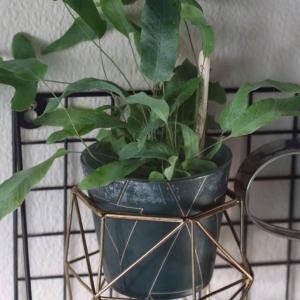

0
0
dormantfig:The gold thing was like a pencil holder from a stationary shop and the green pot was from an old candle!
cclecombe:This is so pretty, but I also love your decor!






